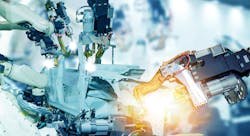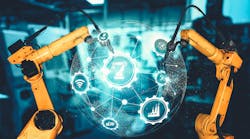Where Manufacturing Technology Goes in 2023: Part 2, Sustainability & Automation
Technology Aids Sustainability
Manufacturers increasingly pay attention to ESG requirements not only to enable Lean policy but also to attract employees and customers. Technology plays a significant role in this effort.
"Organizations are building new, true Industry 4.0 facilities from the ground up to maximize visibility and unlock new decision-making and performance-optimization capabilities," says Jason Bergstrom, Smart Factory Go-to-Market leader at Deloitte Consulting.
"One interesting benefit we see emerging from Industry 4.0 initiatives is the enhanced transparency provided to sustainability programs," says John Lytle, director, manufacturing, with global technology research and advisory firm ISG. "Reporting frameworks are emerging from the system integrators, leveraging the vast amounts of data these plant systems are generating to enhance and automate reporting."
"Many customers will continue to drive for higher levels of sustainability across their entire ecosystem, including additive manufacturing," says Reji Puthenveetil, executive vice president of Industrial Solutions at 3D Systems. "While AM is inherently less wasteful than subtractive processes, I expect there will be a need to address and provide strategies around the recyclability of advanced materials, bringing manufacturing closer to the customer (reducing transportation), energy used versus traditional methods, production on-demand, and other efficiencies that will lead to a sustainable future."
"Green tech start-ups are taking advantage of our new technologies faster. These agile players are amplifying this evolution with fresh eyes and willing attitudes," says Paul Rogers, president and CEO of the Americas at Hexagon AB’s Hexagon Manufacturing Intelligence division. "Heading into product development with the ability to measure quality parameters of design intent and simulate these results is leading the industry to reduced costs, accelerated time to market, and exciting new material development."
Automation’s Steady Robotic Advance
The staple technology when it comes to modernizing plants, automation now includes more than just large, industrial robots. Smaller cobots, often in the form of robot arms, work on the line near humans. And, autonomous mobile robots can handle material transport across plant floors.
This technology perfectly addresses the “three D’s” of plant operations—dirty, dull, and dangerous—and lets employees shift to tasks that require human intuition and problem-solving and/or upskill to new positions. In 2023, automation will continue to advance.
“No-code and easier-to-use robotics will become more commonplace in 2023,” says Jeff Burnstein, president of the Association for Advancing Automation (A3). “Making robots easier to use, especially with no programming required, allows more companies to automate, especially small and medium-sized companies who are new to automation and don’t always have the in-house capabilities to handle complicated programming and set-up tasks.”
“Mobile robots should continue to show strong growth in the year ahead in manufacturing factories as well as warehouses and distribution centers, with the e-commerce demand and continued labor shortages. As every industry struggles to find people, the move to automation will continue” says Burnstein.
“In 2023, economic uncertainty will put additional momentum behind the technology that makes reshoring possible. In creating a distributed network of factories, automation offers a better handle on costs and enables a high level of flexibility that makes scaling easier,” says Paolo Avagliano, COO at Bright Machines.
“In addition, unlike manual labor, the cost of implementing an intelligent automation solution varies little across geographies, allowing the industry to move production from low- to higher-labor-cost regions to build closer to where they sell and mitigate future risk. As a result, the rise of resilient, software-driven automation mitigating the barriers to reshoring will continue in the coming years," Avagliano says.
Related technologies that serve robotics deployments will also see advances in 2023.
“Advancements in edge AI computation are helping to simplify robot programming and make them more adaptable. More efficient processing will require hardware accelerators to compute AI algorithms more efficiently,” says Matthias Thoma, robotics system manager at TI industrial systems.
“To enhance cobots, quality inspection, factory synchronization and inventory accuracy, companies will increase usage of computer vision regardless of their industry,” says Jason Bergstrom, Smart Factory Go-to-Market leader at Deloitte Consulting.
















